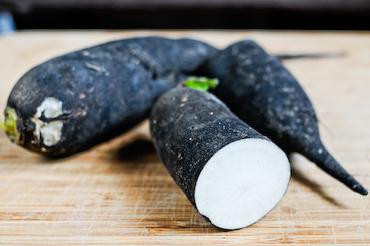Radish is a well-known root vegetable, it is consumed raw, and is also used to prepare various sauces and seasonings. Useful properties of radish have been known since time immemorial. Due to the fact that it does not deteriorate until winter, it can serve as an excellent helper in the fight against vitamin deficiency in the winter, when our body so needs vitamins.

The use of radish is that it has a beneficial effect on the state of the stomach and intestines, thanks to the dietary fiber included in its composition.
In terms of volatile content, it is equal to horseradish and onion, they
give the radish a bitter taste. And the content of essential oils in the radish allows you to use it as an antibiotic during diseases such as flu, pneumonia, bronchitis, tonsillitis, whooping cough.
It is also perfect for healing the intestinal flora.
In addition, the useful properties of radish are that it can be used for edema of varying degrees, with urolithiasis, as well as for atherosclerosis and colds.
It is useful for people suffering from high blood pressure to use this vegetable, because

that the substances contained in it are able to cleanse blood vessels and remove "bad cholesterol."
Calorie radish is small, only 35 kilocalories per 100 grams of product. About 6.7 g of carbohydrates, 0.2 g of fat, 2 g of protein are per 100 grams of product. Due to its low calorie content and the ability to remove excess fluid, harmful substances and wastes from the body, it contributes to rapid weight loss. Therefore, the use of radishes in dried, raw or boiled form will help those who want to lose a couple of extra pounds.
The main useful properties of radish are manifested due to the content of a large number of vitamins, such as C, A, E, B1, B2, B5, B6, PP, beta-carotene. In addition, it contains such important trace elements as iodine, calcium, potassium, sodium, phosphorus, copper, fluorine and iron, in addition, fiber. Radish is not only tasty, it is also very healthy. To preserve nutrients and vitamins, it is recommended to use it in its raw form.

For diseases of the gall bladder and liver, it is good to use fresh juice from this vegetable, which is also useful for kidney diseases, including urolithiasis. Radish juice as a composition for grinding is used for pain in joints and intercostal neuralgia, and it is also used to wash purulent wounds and ulcers. And compresses help well with gout.
Use the properties of radish in home cosmetology. Old recipes based on it help in removing freckles and age spots. Radish masks with sour cream help in the fight against aging skin. A massage of the scalp with the rubbing of its juice helps to strengthen and improve the condition of the hair.
But, despite the fact that radish is very useful for the body, it should be used with caution. People suffering from a disease of the duodenum and stomach ulcer should exclude this vegetable from their diet. Also, those who suffer from increased acidity of the stomach should abandon the use of radish.